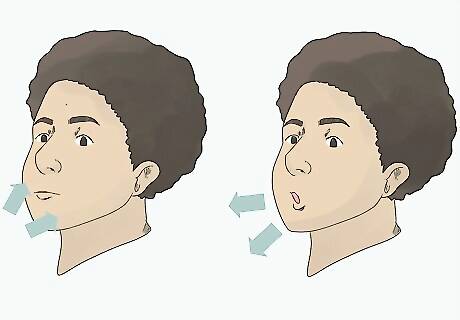
views
- Prevent straining and vocal cracks by standing up straight with your feet spaced shoulder-width apart.
- Work on your breathing techniques by learning to inhale quickly and exhale in a smooth, controlled way.
- Improve your vocal technique by practicing vocal warm-ups, dynamic changes, note jumps, vowel pronunciations, and scales.
- Practice each day in short sessions so you don't strain your voice.
Learning Proper Posture and Breathing

Stand up straight. You’ve probably heard this command again and again, and here it goes once more. Good posture helps prevent straining and voice cracks. Correct posture is important for a singer to reach their full potential. Stand tall with one foot slightly in front of the other one and feet shoulder-width apart. Make sure that your chest is high to give room for your lungs to expand and contract. This allows you to breathe easily and reach maximum lung capacity, which equals better notes and phrases. Imagine that a string, running through your spine and out the top of your head, is lifting you up. Keep your chin parallel with the ground. If you're sitting, the same things apply. Move to the front half of the seat, and keep both of your feet flat on the floor. Don't cross your legs. Keeping your body in line allows for more control and sustained singing without strain. Try to keep your back straight, and avoid touching the back of the seat.

Find a position that makes you feel relaxed and confident. Although there are some basics you should follow, everyone is different. Find a position that makes you feel like a superstar. Of course, you won’t sing at your best from a slouched position, but singing with an extremely straight back may feel uncomfortable for you. Try singing in different positions until you find that sweet spot. Try standing with your back and head against the wall or lie down on the floor on your back with your head on the ground. Both techniques will ensure your spine remains straight.

Breathe properly. Breathing is 80% of singing--that makes your voice a wind instrument of sorts! Proper singing begins and ends with proper breathing. Work on taking deep breaths that come from the depths of your stomach. Inhale for 8 counts, then exhale for 8 counts. Feeling more relaxed?

Practice breathing exercises. Try the book method, which is practical and kind of fun, too. Lie on the ground and place a book on your stomach. When you inhale, try to make the book rise. Sing a comfortable note, and when you are exhaling/singing, make the book lower.

Learn to inhale quickly. To sing well, you need to learn how to gather a lot of air with a quick inhalation. With your lungs and a bit of imagination, this technique is simple. Begin by breathing in and pretending that the air is heavy. Allow it to fall deeply within your body. Then, breathe in faster, still imagining the air as heavy, but let it fall deeply into your body at a faster rate. Continue to do this until you can take in a lot of air at a quick pace. If you’re feeling extra imaginative, you can also practice pretending that your lungs are balloons that you are filling with air. Try taking a snatch breath -- this is a quick inhalation you would take when someone is walking away from you and you just realized you have something else to say to them.

Control your exhalation. If you want to blow others (or yourself) away with a strong, smooth voice, work towards a smooth and sustained exhalation. To do this, practice exhaling by blowing on a feather or blowing out a candle flame. Take a feather and try to blow it in the air (or stand far back and blow on the candle flame so it flickers) with one long breath. As you are doing this, your abdomen should begin to return to its normal size, but your chest should not collapse. Repeat this exercise until you are comfortable with long, steady exhales. Exhale until you feel like you’ve pushed all the air from your lungs.
Working on Technique and Vocal Exercises

Practice your warm ups. Singing is like exercise: you should get nice and warm beforehand to avoid injury. Sing in your middle range, then low range, then high range, and back to the middle. Relax, then try again carefully. If you feel your voice begin to strain, stop and give yourself some time to rest. Be kind to your voice. After all, it’s your ticket to beautiful singing.

Work on dynamics. If your heart has ever beat a little faster when a song transitions from a soft melody to a loud, emotional chorus, you probably understand the power of dynamics. The more you practice, the louder and softer you'll be able to sing healthily. Start singing a comfortable pitch and then crescendo to loud then decrescendo to soft. When you start out, you will probably only be able to sing from mp (mezzo piano or moderately quiet) to mf (mezzo forte or moderately loud), but your range will increase with practice. Practice the lip trill Celine Dion uses, which you can see here: https://www.youtube.com/watch?v=1NFz2Ff6ZlM.

Work on agility. Sing from do to so, back to do quickly back and forth, trying to hit all of the notes. Do this in increments of half steps on different syllables. This “voice stretching” makes for a more flexible voice. If you need help staying on pitch, use an app like SingTrue.

Pronounce your vowels correctly. Practice all of your vowels at every pitch (high, low, and in between). There are very few pure vowels in English. Instead, you will normally encounter something called diphthongs, a weird-sounding word that simply means two or more vowel sounds joined together. Some pure vowels to practice are: AH as in "father", EE as in "eat", IH as in "pin", EH as in "pet", OO as in "food", UH as in "nut", EU as in "could", OH as in "home".

Practice scales. Practice these often, especially if pitch gives you some trouble. Most coaches will recommend 20-30 minutes a day when starting out, as practicing scales will also strengthen the muscles used for singing. Buff voice muscles will give you better control. To practice scales, identify your range (tenor, baritone, alto, soprano, etc.) and know how to find the notes that cover your range on a keyboard or piano. Then, practice the major scales in every key, moving up and down using the vowel sounds. If you're unfamiliar with scales, search online for videos that demonstrate how to do them. If the vocalist sings notes out of your range, simply skip them.
Practicing Singing

Set aside daily time for singing. Practice, practice, practice! To improve your singing voice, it is important to practice every day. Think of singing as an exercise for a voice. If you take a long break from exercising, you’ll be a sweaty, panting mess next time you try to exercise again. Even if you only have time to practice warm-ups in the car on the way to work, that is okay. If possible, set aside specific times every day for practice. It's best to practice for multiple short sessions than a single long session. For instance, practice from 9-9:15, 11-11:15, and 1-1:15 every day.

Practice for a short amount of time. Instrumentalists may be able to practice for hours at a time, but that isn’t the case for singers. An overused, strained voice is not a happy voice. Try to practice anywhere between 30 and 60 minutes a day. You should not practice for more than 60 minutes. If you’re feeling ill or tired, give your voice some more downtime. Do not push yourself if you feel that you can’t practice for 30 minutes. Spend the time you do practice wisely and intentionally so you can get a lot done within 10-15 minutes.

Purchase an at-home singing course. There are also a few at-home vocal training courses out there, such as Singing Success, Sing and See, Singorama, and Vocal Release. They are not as pricey as in-person vocal lessons, but be sure to do your research to see which ones have worked for other singers.

Take lessons from a professional. If you are dedicated to singing, consider taking professional lessons. Find a vocal coach or qualified voice teacher who can help you become the singer you want to be. Check with your local music store or your school music teacher for trustworthy references. Lessons can be costly. Consider how important singing is to you before signing up for lessons.

Join a local choir. If you cannot afford a teacher, or do not want the dedication that comes with hiring a professional voice coach, consider joining a local choir. You might associate choirs with church, but you can find them across a number of different organizations. Choirs are a great way to learn about singing and meet cool people who share your love for music at the same time. Keep in mind that you may have to audition to join the choir. Relax, and do your best. You’ve got this!

Check your progress over time. Record yourself singing and save the recording. Then, work on your voice consistently over the next 3 months. After that time, record yourself singing the same song and compare the 2 recordings. You'll be able to see where you've improved and what you still need to work on.




















Comments
0 comment